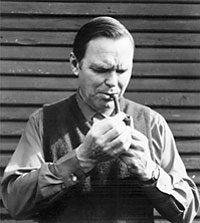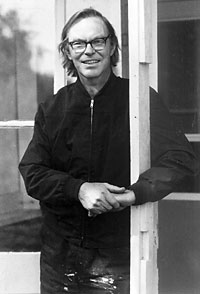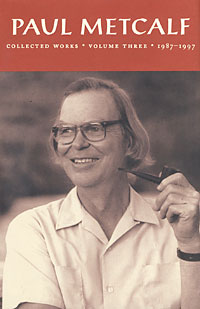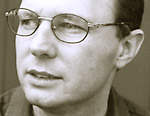
| Jacket 35 — Early 2008 | Jacket 35 Contents page | Jacket Homepage | Search Jacket |
The Internet address of this page is http://jacketmagazine.com/35/r-metcalf-rb-mccooey.shtml
Paul Metcalf
Collected Works
reviewed by David McCooey
Volume One: 1956—76, 591 pp;
Volume Two: 1976—1986, 598 pp;
Volume Three: 1987—1997, 524 pp,
hardback, Coffee House, 1997, np, I-56689—050—0.
This review is about 5 printed pages long. It is copyright © David McCooey and Jacket magazine 2008.
1
Poor Paul Metcalf (1917–99) doesn’t rate a mention in The Oxford Companion to Twentieth-Century Poetry in English (1994), The Routledge Who’s Who of Twentieth-Century World Poetry (2000), or The Oxford Companion to American Literature (2002). It’s no surprise, then, that he has been described as a ‘cult’ figure, or that his supporters (who have included Robert Creeley, William Gass, and Guy Davenport) should so bemoan his lack of presence in the literary landscape. As Davenport writes in his Introduction to Metcalf’s Collected Works, ‘He has notoriously and scandalously been at the periphery’. This was in part because his books were published by small presses. But it was (and is) also a reflection of the fact that he does not write in a conventional (let alone ‘popular’) style. Coffee House Press, who handsomely published the Collected Works in three volumes in 1997, were roundly congratulated for bringing Metcalf closer to the mainstream, but his absence in a standard reference work like The Oxford Companion to American Literature shows that Metcalf remains very much a minority figure.

Paul Metcalf,
photo by Jonathan Williams
paragraph 2
Metcalf’s absence in the poetry reference books can be explained by the fact that his status as a poet is not at all clear. His absence in The Oxford Companion to American Literature, though, is something of an irony given Metcalf’s knowledge of and intervention in his national literature, as well as his almost-mythopoeic and encyclopedic obsession with things American (North and South), from history and geography to literature and baseball. Ignored as both a poet and an American, Metcalf is given an entry in the more inclusively conceived The Oxford Companion to Twentieth-Century Literature in English (1996), which describes his books as ‘beautifully composed alternative histories of America’. These alternative histories cover large areas of space and time, taking in Native American and colonial history, the Civil War, and the War in the Pacific, as well as figures such as Edgar Allen Poe, John Wilkes Booth, and Herman Melville, Metcalf’s great grandfather.
3
Melville almost book-ends Metcalf’s Collected Works, starring in both the second work, Genoa (1965), and the last, ‘The Wonderful White Whale of Kansas’ (1997). Metcalf’s mother was Melville’s literary executor, and the manuscript of Billy Budd was found (by Raymond M. Weaver) in the Metcalf family home in 1921, something Metcalf remembered in adulthood. With such an antecedent it is no surprise that Melville’s presence is felt not just at the beginning and the end, but also throughout Metcalf’s Collected Works. Along with Poe, Dickinson and Whitman, Melville preeminently represents the obscure-but-ambitious nineteenth-century American writer who turns out to be at the heart of America’s modern literary tradition. Ambition and tradition are strangely at the heart of Metcalf’s work, ‘strangely’ if one considers Metcalf ‘experimental’ or ‘postmodern’. But those writers — Poe, Dickinson, Whitman, and Melville — are all central to modern American literary tradition precisely because they bridge that gap between the old and the new, or between what we might call postromanticism and modernism. Metcalf, in his desire to unite the radically disjunct, in his impatience with categories such as ‘poetry’ and ‘prose’, and in his interest in America as a subject, is equally postromantic as well as late- or post-modernist.

Paul Metcalf,
photo by Marylin Patti
4
It is fitting, then, that Genoa, Metcalf’s first major ‘alternative history of America’, concentrates on the surprising connections between Melville and that ‘discoverer’ of America, Christopher Columbus. With its use of bricolage (the assemblage of a text through the quotation of other texts), analogy, and startlingly fertile juxtapositions, Genoa is notably Melvillean, as well as the blueprint for much of Metcalf’s later work (though he was to drop the desire, still observable in Genoa, to include more ‘conventional’ fictions in his collages, if one can describe the outré story of the narrator and his brother ‘conventional’). As we see in Genoa, it is possible for the kind of juxtaposition that bricolage produces to become a kind of metaphor in itself. Indeed, it is understandable that Metcalf should state in an interview with John O’Brien that ‘I am much happier, and always have been, with the word juxtaposition than I am with metaphor’ (http://dalkeyarchive.com/interviews/602/paul-metcalf).
5
The use of Melville’s texts in Genoa can indeed be startling and startlingly metaphorical. It also shows the sheer power of Melville’s writing. For instance, Metcalf quotes this from Moby-Dick: ‘for long months of days and weeks, Ahab and anguish lay stretched together in one hammock, rounding in mid winter that dreary, howling Patagonian Cape; then it was, that his torn body and gashed soul bled into one another’. Quotation, as Borges knew, is an art form, but it is hard to see how one can go wrong with such materials. But Genoa is much more than quotation. It is a work — like most of Metcalf’s later works — that presents startling connections between things. As Guy Davenport writes in his Introduction, ‘Genoa is built: it is an architecture of analogies, similitudes, and Melvillean metaphors’. Another metaphor for Metcalf’s work is ‘symphonic’, and the symphonic nature of Metcalf’s writing makes quotation from it extremely hard. In Genoa, for instance, the connections between sperm, whales, monsters, the body, sea creatures, and islands are impossible to demonstrate through brief quotation. It is fair enough that Metcalf in the prose fragment ‘Play it Again, Sam’ (from Where Do You Put The Horse? 1986), chooses to report a conversation with his daughter, in which she says to him: ‘You’ve brought literature to music’.
6
Linking the disparate is a particular feature of the writings of Melville (he who could make a whale mean almost anything) and a method that Metcalf has clearly put to use in works such as I-57 (1988) and The Middle Passage (1976). The former takes its title both from a highway (the Interstate 57) and the author (‘I, Paul Metcalf, aged 57’). The connections between the three subjects of The Middle Passage, Metcalf’s darkest work, are only made explicit in the work’s subtitle: A Triptych of Commodities. The three commodities are the looms that the Luddites feared, slaves, and whales. In Patagoni (1971) another piece relying on juxtapositions, the connection is between pre-conquest South American cultures and Henry Ford’s car. (Throughout his career Metcalf wrote powerfully and at length about the effects of colonialism). In Both (1982) surprising connections are made between Poe and Booth.

Paul Metcalf
photo by Steven Trubitt
7
This returns us to the ‘alternative histories of America’, a project that is given its lightest and wittiest rendition in Zip Odes (1979), a work made up of 51 poems, one for each state and the District of Columbia, that are ‘composed entirely of place names, as they appear, state by state, in the U.S. Postal Service Zip Code Directory (1968 edition)’. The great dream of America-as-poem, originated in the writing of figures such as Emerson and Whitman, here finds expression, but one that is both ironic and comic. ‘Kansas’, for instance reads ‘Pretty Prairie, Bird City / Sunflower Bloom // Rice, Maize, / Liberal Gas // Learned University: / Stark Hope, Soldier’. At the opposite extreme, in terms of scale, is Waters of Potowmack (1982), Metcalf’s account of the geography, history, and politics of that work’s eponymous river (with its variant spellings). Waters of Potowmack relies on a myriad of (generally uncredited) sources. Here, the temporal distance makes almost any language — lists, laws, diary entries — powerfully poetic. As Metcalf puts it in ‘The Poet and History’ (1975), ‘history — and the varieties of language that ride with it — [is] a vast resource’. For instance, ‘For fish the Riuers are plentifully stored, with Sturgeon, Porpusse, Base, Rockfish, Carpe, Shad, Herring, Ele, Catfish, Perch, Flatfish, Troute, Sheepes-head, Drummers, Iarfish, Creuises, Crabbes, Oisters and diuerse other kindes’. The long ‘s’ retained by Metcalf adds to the poetic strangeness of such a list.
8
The Oxford Companion to Twentieth-Century Literature in English describes Metcalf as an ‘American prose writer’. This is a reasonable description, but it doesn’t account for when Metcalf doesn’t write in prose, nor does it account for the fact that much of his ‘writing’ is other people’s. Metcalf himself deals with the issue of what it is that he writes. I-57 begins with the assertion that what we are about to read is ‘Not a poem, not a novel, not a history, not a journal, yet at times some or all of these’. Negative definition seems to be the only way to describe what it is Metcalf is offering us. But Metcalf concerns himself with the relationship between poetry and prose elsewhere in his work. In ‘The Categories’, one of the eighteen pieces — fragments and essays — that make up Where Do You Put the Horse?, Metcalf considers the neat division conventionally made between poetry and prose, poets and prose writers. For Metcalf, this division is ‘more than a little ridiculous’ in view of the ‘subliminal drive in two of our major forebears — Poe and Melville — to violate the questionable boundary between the two genres’. It is characteristic of Metcalf that he should evoke these two canonical figures (who also play significant roles in the rest of his oeuvre) to suggest what it is that he is seeking, an American tradition: ‘Perhaps this is what I’m after: that the reach in our literature, our tradition...originates in prose, a dirt-prose, that in the power and energy of its own passion forces the gates of poetry. No wooden horse, no gimmicks — just sheer force’.
9
Such ‘sheer force’ has already been seen in the quotation of Moby-Dick. But a revisionist poetics that relies so profoundly on writing of the past has certain effects. While Metcalf is something of a ‘new historicist’ (recognising the ‘historicity of texts and the textuality of history’), his interests in geography, labour history, and colonialism tends to obscure certain subjects and subjectivities. Metcalf’s Collected Works is tremendously blokey. Its ‘alternative histories’ tend not to include women (Araminta and the Coyotes, 1991, being a rare exception), and as his statement above suggests, his literary precursors are invariably men (writing with ‘sheer force’).
10
For all of Metcalf’s originality and lack of conventionality, then, his project is one of furthering the American literary tradition. As such, coherence is more interesting for him than chaos, sanity preferable to madness. In ‘Where Do You Put the Horse?’ (1979) he writes of his ‘plunges’ into history in the following terms: ‘First, the plunge, the descent into hell, the near-drowning, if you wish; then the return to the surface. Because, if you drown, who cares? And if you don’t plunge, who cares?’ For Metcalf, the most interesting journey is the kind that has had ascendancy for thousands of years, the journey ‘from chaos toward order’. Long and difficult though most of them may be, Metcalf’s works do offer startling visions of order even in the most apparently disordered of contexts.

David McCooey
David McCooey has written widely on Australian poetry (including the contemporary poetry chapter in A Companion to Australian Literature Since 1900). His book of poems, Blister Pack (Salt), won the Mary Gilmore Award in 2006 and was short-listed for four other major awards. He lives in Geelong, Victoria, where he is a senior lecturer at Deakin University.